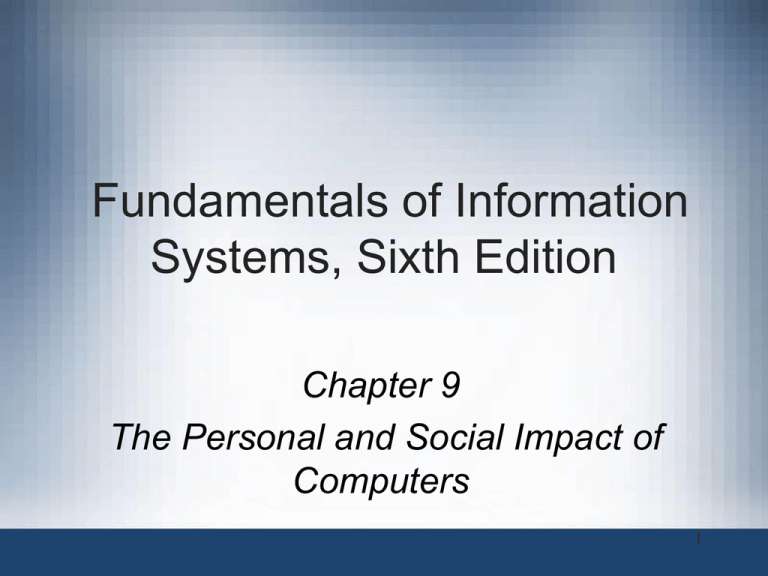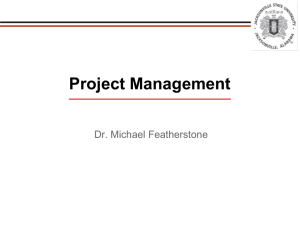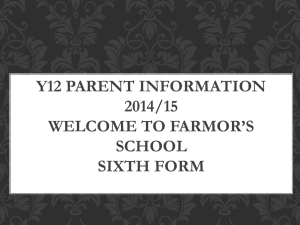
Fundamentals of Information
Systems, Sixth Edition
Chapter 9
The Personal and Social Impact of
Computers
1
Principles and Learning Objectives
• Policies and procedures must be established to
avoid waste and mistakes associated with
computer usage
– Describe some examples of waste and mistakes in
an IS environment, their causes, and possible
solutions
– Identify policies and procedures useful in eliminating
waste and mistakes
– Discuss the principles and limits of an individual’s
right to privacy
Fundamentals of Information Systems, Sixth Edition
2
Principles and Learning Objectives
(continued)
• Computer crime is a serious and rapidly growing
area of concern requiring management attention
– Explain the types of computer crime and their effects
– Identify specific measures to prevent computer crime
Fundamentals of Information Systems, Sixth Edition
3
Principles and Learning Objectives
(continued)
• Jobs, equipment, and working conditions must be
designed to avoid negative health effects from
computers
– List the important negative effects of computers on
the work environment
– Identify specific actions that must be taken to ensure
the health and safety of employees
Fundamentals of Information Systems, Sixth Edition
4
Principles and Learning Objectives
(continued)
• Practitioners in many professions subscribe to a
code of ethics that states the principles and core
values that are essential to their work
– Outline criteria for the ethical use of information
systems
Fundamentals of Information Systems, Sixth Edition
5
Why Learn About the Personal and
Social Impact of the Internet?
• Both opportunities and threats:
– Surround a wide range of nontechnical issues
associated with the use of information systems and
the Internet
• You need to know about the topics in this chapter:
– To help avoid becoming a victim of crime, fraud,
privacy invasion, and other potential problems
Fundamentals of Information Systems, Sixth Edition
6
Computer Waste and Mistakes
• Computer waste:
– Inappropriate use of computer technology and
resources
• Computer-related mistakes:
– Errors, failures, and other computer problems that
make computer output incorrect or not useful
Fundamentals of Information Systems, Sixth Edition
7
Computer Waste
• Spam filter:
– Software that attempts to block unwanted e-mail
– Some might require first-time e-mailers to be verified
before their e-mails are accepted
• Image-based spam:
– New tactic spammers use to circumvent spamfiltering software
Fundamentals of Information Systems, Sixth Edition
8
Computer-Related Mistakes
• Common causes:
– Unclear expectations and a lack of feedback
– Program development that contains errors
– Incorrect data entry by data-entry clerk
Fundamentals of Information Systems, Sixth Edition
9
Preventing Computer-Related Waste
and Mistakes
• Preventing waste and mistakes involves:
– Establishing, implementing, monitoring, and
reviewing effective policies and procedures
Fundamentals of Information Systems, Sixth Edition
10
Establishing Policies and Procedures
• Types of computer-related mistakes:
–
–
–
–
Data-entry or data-capture errors
Errors in computer programs
Mishandling of computer output
Inadequate planning for and control of equipment
malfunctions
– Inadequate planning for and control of environmental
difficulties
– Installing computing capacity inadequate for the
level of activity
– Failure to provide access to the most current
information
Fundamentals of Information Systems, Sixth Edition
11
Implementing Policies and Procedures
• Policies to minimize waste and mistakes:
– Changes to critical tables, HTML, and URLs should
be tightly controlled
– User manual should be available covering operating
procedures
– Each system report should indicate its general
content in its title
– System should have controls to prevent invalid and
unreasonable data entry
Fundamentals of Information Systems, Sixth Edition
12
Monitoring Policies and Procedures
• Monitor routine practices and take corrective action
if necessary
• Implement internal audits to measure actual results
against established goals
Fundamentals of Information Systems, Sixth Edition
13
Reviewing Policies and Procedures
• Questions to be answered:
– Do current policies cover existing practices
adequately?
– Does the organization plan any new activities in the
future?
– Are contingencies and disasters covered?
Fundamentals of Information Systems, Sixth Edition
14
Computer Crime
• Top four categories of computer crime reported to
law enforcement organizations during 2009:
–
–
–
–
Undelivered merchandise or nonpayment
Identity theft
Credit card fraud
Auction fraud
Fundamentals of Information Systems, Sixth Edition
15
The Computer as a Tool to Commit
Crime
• Social engineering:
– Using social skills to get computer users to provide
information to access an information system
• Dumpster diving:
– Going through trash cans to find secret or
confidential information
Fundamentals of Information Systems, Sixth Edition
16
Cyberterrorism
• Homeland Security Department’s Information
Analysis and Infrastructure Protection Directorate:
– Serves as a focal point for threat assessment,
warning, investigation, and response for threats or
attacks against the country’s critical infrastructure
• Cyberterrorist
– Intimidates or coerces a government or organization
to advance his or her political or social objectives
Fundamentals of Information Systems, Sixth Edition
17
Identity Theft
• Imposter obtains personal identification information
in order to impersonate someone else:
– To obtain credit, merchandise, and services in the
name of the victim
– To have false credentials
• More than six million customers of online
brokerage firm TD Ameritrade were:
– Involved in a class action lawsuit resulting from a
data theft
Fundamentals of Information Systems, Sixth Edition
18
Internet Gambling
• Revenues generated by Internet gambling
represent a major untapped source of income for
the state and federal governments
• Study that showed that:
– While people of all income levels played state lottery
games, those people with an annual income of less
than $10,000 spent nearly three times as much
Fundamentals of Information Systems, Sixth Edition
19
The Computer as a Tool to Fight
Crime
• Leads Online Web-based service system:
– Used by law enforcement to recover stolen property
– Contains more than 250 million records in its
database
– Allows law enforcement officers to search the
database by item serial number or by individual
Fundamentals of Information Systems, Sixth Edition
20
Monitoring Sex Offenders
• Offender Watch:
– Web-based system used to track registered sex
offenders
– Stores the registered offender’s address, physical
description, and vehicle information
• GPS tracking devices and special software:
– Used to monitor the movement of registered sex
offenders
Fundamentals of Information Systems, Sixth Edition
21
Use of Geographic Information
Systems
• Enables law enforcement agencies to gain a quick
overview of crime risk at a given address or in a
given locale
• Common GIS systems include:
– The National Equipment Registry
– The CompStat program
– CargoNet
Fundamentals of Information Systems, Sixth Edition
22
The Computer as the Object of Crime
• Crimes fall into several categories:
–
–
–
–
–
–
Illegal access and use
Data alteration and destruction
Information and equipment theft
Software and Internet piracy
Computer-related scams
International computer crime
Fundamentals of Information Systems, Sixth Edition
23
Fundamentals of Information Systems, Sixth Edition
24
Illegal Access and Use
• Hacker:
– Learns about and uses computer systems
• Criminal hacker:
– Gains unauthorized use or illegal access to
computer systems
• Script bunny:
– Automates the job of crackers
• Insider:
– Employee who compromises corporate systems
Fundamentals of Information Systems, Sixth Edition
25
Illegal Access and Use (continued)
• Virus:
– Program file capable of attaching to disks or other
files and replicating itself repeatedly
• Worm:
– Parasitic computer program that replicates but,
unlike viruses, does not infect other computer
program files
• Trojan horse:
– Malicious program that disguises itself as a useful
application or game and purposefully does
something the user does not expect
Fundamentals
of Information
Systems,Systems,
Sixth EditionSixth
Fundamentals
of Information
Edition
26
26
Illegal Access and Use (continued)
• Rootkit:
– Set of programs that enable its user to gain
administrator level access to a computer or network
• Logic bomb:
– Type of Trojan horse that executes when specific
conditions occur
• Variant:
– Modified version of a virus that is produced by
virus’s author or another person
Fundamentals of Information Systems, Sixth Edition
27
Spyware
• Software installed on a personal computer to:
– Intercept or take partial control over user’s
interaction with the computer without knowledge or
permission of the user
• Similar to a Trojan horse in that:
– Users unknowingly install it when they download
freeware or shareware from the Internet
Fundamentals of Information Systems, Sixth Edition
28
Information and Equipment Theft
• Password sniffer:
– Small program hidden in a network that records
identification numbers and passwords
• Portable computers such as laptops and portable
storage devices are especially easy for thieves to
take:
– Data and information stored in these systems are
more valuable than the equipment
Fundamentals of Information Systems, Sixth Edition
29
Safe Disposal of Personal Computers
• Deleting files and emptying the Recycle Bin does
not make it impossible for determined individuals to
view the data
• Use disk-wiping software utilities that overwrite all
sectors of your disk drive, making all data
unrecoverable
Fundamentals of Information Systems, Sixth Edition
30
Patent and Copyright Violations
• Software piracy:
– Act of unauthorized copying or distribution of
copyrighted software
– Penalties can be severe
• Patent infringement:
– Occurs when someone makes unauthorized use of
another’s patent
Fundamentals of Information Systems, Sixth Edition
31
Computer-Related Scams
• Over the past few years:
– Credit card customers of various banks have been
targeted by scam artists trying to get personal
information
• Vishing:
– Similar to phishing
– Instead of using the victim’s computer, it uses the
victim’s phone
Fundamentals of Information Systems, Sixth Edition
32
International Computer Crime
• Computer crime becomes more complex when it
crosses borders
• Money laundering:
– Disguising illegally gained funds so that they seem
legal
Fundamentals of Information Systems, Sixth Edition
33
Preventing Computer-Related Crime
• Efforts to curb computer crime are being made by:
–
–
–
–
Private users
Companies
Employees
Public officials
Fundamentals of Information Systems, Sixth Edition
34
Crime Prevention by State and
Federal Agencies
• Computer Fraud and Abuse Act of 1986
– Mandates punishment based on the victim’s dollar
loss
• Computer Emergency Response Team (CERT)
– Responds to network security breaches
– Monitors systems for emerging threats
Fundamentals of Information Systems, Sixth Edition
35
Crime Prevention by Corporations
• Guidelines to protect your computer from criminal
hackers:
– Install strong user authentication and encryption
capabilities on your firewall
– Install the latest security patches
– Disable guest accounts and null user accounts
– Turn audit trails on
– Consider installing caller ID
– Install a corporate firewall between your corporate
network and the Internet
Fundamentals of Information Systems, Sixth Edition
36
Crime Prevention by Corporations
(continued)
• Using Intrusion Detection Software:
– Intrusion detection system (IDS):
• Monitors system and network resources
• Notifies network security personnel when it senses a
possible intrusion
• Can provide false alarms
Fundamentals
of Information
Systems,Systems,
Sixth EditionSixth
Fundamentals
of Information
Edition
37
37
Crime Prevention by Corporations
(continued)
• Security Dashboard
– Provides comprehensive display on a single
computer screen of:
• All the vital data related to an organization’s security
defenses, including threats, exposures, policy
compliance, and incident alerts
Fundamentals of Information Systems, Sixth Edition
38
Crime Prevention by Corporations
(continued)
• Using managed security service providers
(MSSPs):
– Many are outsourcing their network security
operations to:
• Managed security service providers (MSSPs) such as
Counterpane, Guardent, IBM, Riptech, and Symantec
• Guarding against theft of equipment and data:
– Organizations need to take strong measures to
guard against the theft of computer hardware and
the data stored on it
Fundamentals
of Information
Systems,Systems,
Sixth EditionSixth
Fundamentals
of Information
Edition
39
39
Crime Prevention for Individuals and
Employees
• Identity theft:
– To protect yourself, regularly check credit reports
with major credit bureaus
• Malware attacks:
– Antivirus programs run in the background to protect
your computer
– Many e-mail services and ISP providers offer free
antivirus protection
Fundamentals of Information Systems, Sixth Edition
40
Crime Prevention for Individuals and
Employees (continued)
• Computer scams:
– Tips to help you avoid becoming a victim:
• Don’t agree to anything in a high-pressure meeting or
seminar
• Don’t judge a company based on appearances
• Avoid any plan that pays commissions simply for
recruiting additional distributors
• Beware of shills
• Beware of a company’s claim that it can set you up in
a profitable home-based business
Fundamentals of Information Systems, Sixth Edition
41
Privacy and the Federal Government
• The federal government:
– Has implemented a number of laws addressing
personal privacy
• European Union:
– Has data-protection directive that requires firms
transporting data across national boundaries to have
certain privacy procedures in place
Fundamentals of Information Systems, Sixth Edition
42
Privacy at Work
• Organizations:
– Monitor employees’ e-mail
– More than half retain and review messages
• Workers claim:
– Their right to privacy trumps their companies’ rights
to monitor employee use of IS resources
Fundamentals of Information Systems, Sixth Edition
43
E-Mail Privacy
• Federal law:
– Permits employers to monitor e-mail sent and
received by employees
• E-mail messages that have been erased from hard
disks can be retrieved and used in lawsuits
• Use of e-mail among public officials might violate
“open meeting” laws
Fundamentals of Information Systems, Sixth Edition
44
Instant Messaging Privacy
• To protect your privacy and your employer’s
property:
– Choose a nonrevealing, nongender-specific,
unprovocative IM screen name
– Don’t send messages you would be embarrassed to
have your family members, colleagues, or friends
read
– Do not open files or click links in messages from
people you do not know
– Never send sensitive personal data such as credit
card numbers via IM
Fundamentals of Information Systems, Sixth Edition
45
Privacy and Personal Sensing Devices
• RFID tags:
– Microchips with antenna
– Embedded in many of the products we buy:
• Medicine containers, clothing, computer printers, car
keys, library books, tires
– Generate radio transmissions that, if appropriate
measures are not taken, can lead to potential
privacy concerns
Fundamentals of Information Systems, Sixth Edition
46
Privacy and the Internet
• Huge potential for privacy invasion on the Internet:
– E-mail messages
– Visiting a Web site
– Buying products over the Internet
• Platform for Privacy Preferences (P3P):
– Screening technology
• Social network services:
– Parents should discuss potential dangers, check
their children’s profiles, and monitor their activities
Fundamentals of Information Systems, Sixth Edition
47
Internet Libel Concerns
• Libel:
– Publishing an intentionally false written statement
that is damaging to a person’s or organization’s
reputation
• Individuals:
– Can post information to the Internet using
anonymous e-mail accounts or screen names
– Must be careful what they post on the Internet to
avoid libel charges
Fundamentals of Information Systems, Sixth Edition
48
Filtering and Classifying Internet
Content
• Filtering software:
– Helps screen Internet content
• Internet Content Rating Association (ICRA):
– Goals are to protect children from potentially harmful
material while also safeguarding free speech on the
Internet
Fundamentals of Information Systems, Sixth Edition
49
Fairness in Information Use
• The Privacy Act of 1974:
– Provides privacy protection from federal agencies
– Applies to all federal agencies except the CIA and
law enforcement agencies
– Requires training for all federal employees who
interact with a “system of records” under the act
Fundamentals
of Information
Systems,Systems,
Sixth EditionSixth
Fundamentals
of Information
Edition
50
50
Electronic Communications Privacy
Act
• Gramm-Leach-Bliley Act:
– Requires financial institutions to protect customers’
nonpublic data
• USA Patriot Act:
– Internet service providers and telephone companies
must turn over customer information
• Corporate privacy policies:
– Should address a customer’s knowledge, control,
notice, and consent over the storage and use of
information
Fundamentals of Information Systems, Sixth Edition
51
Individual Efforts to Protect Privacy
• To protect personal privacy:
– Find out what is stored about you in existing
databases
– Be careful when you share information about
yourself
– Be proactive to protect your privacy
– Take extra care when purchasing anything from a
Web site
Fundamentals of Information Systems, Sixth Edition
52
The Work Environment
• Use of computer-based information systems has
changed the workforce:
– Jobs that require IS literacy have increased
– Less-skilled positions have decreased
• Enhanced telecommunications:
– Has been the impetus for new types of business
– Has created global markets in industries once limited
to domestic markets
Fundamentals of Information Systems, Sixth Edition
53
Health Concerns
•
•
•
•
Occupational stress
Seated immobility thromboembolism (SIT)
Carpal tunnel syndrome (CTS)
Video display terminal (VDT) bill:
– Employees who spend at least four hours a day
working with computer screens should be given 15minute breaks every two hours
Fundamentals of Information Systems, Sixth Edition
54
Avoiding Health and Environment
Problems
• Work stressors:
– Hazardous activities associated with unfavorable
conditions of a poorly designed work environment
• Ergonomics:
– Science of designing machines, products, and
systems to maximize safety, comfort, and efficiency
of people who use them
Fundamentals of Information Systems, Sixth Edition
55
Ethical Issues in Information Systems
• Code of ethics:
– States the principles and core values essential to a
set of people and, therefore, governs their behavior
– Can become a reference point for weighing what is
legal and what is ethical
Fundamentals of Information Systems, Sixth Edition
56
Summary
• Computer waste:
– The inappropriate use of computer technology and
resources in both the public and private sectors
• Preventing waste and mistakes involves:
– Establishing, implementing, monitoring, and
reviewing effective policies and procedures
• Some crimes use computers as tools
• Cyberterrorist:
– Intimidates or coerces a government or organization
to advance his or her political or social objectives
Fundamentals of Information Systems, Sixth Edition
57
Summary (continued)
• To detect and prevent computer crime, use:
– Antivirus software
– Intrusion detection systems (IDSs)
• Privacy issues:
– A concern with government agencies, e-mail use,
corporations, and the Internet
• Businesses:
– Should develop a clear and thorough policy about
privacy rights for customers, including database
access
Fundamentals of Information Systems, Sixth Edition
58
Summary (continued)
• Computer-related scams:
– Have cost people and companies thousands of
dollars
• Ergonomics:
– The study of designing and positioning computer
equipment
• Code of ethics:
– States the principles and core values that are
essential to the members of a profession or
organization
Fundamentals of Information Systems, Sixth Edition
59








